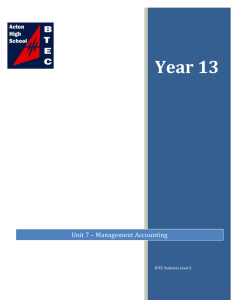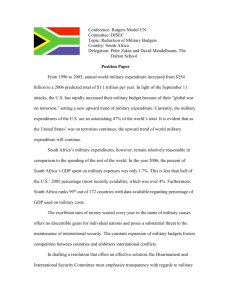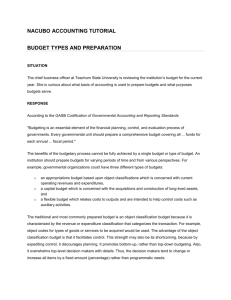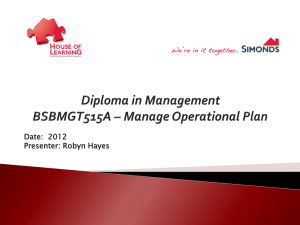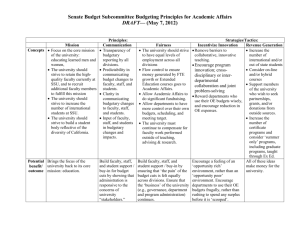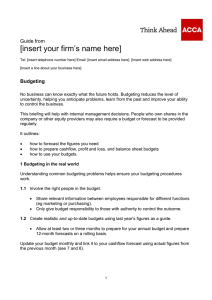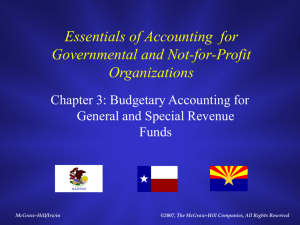hgLevel 4 budgeting Scheme of work
advertisement
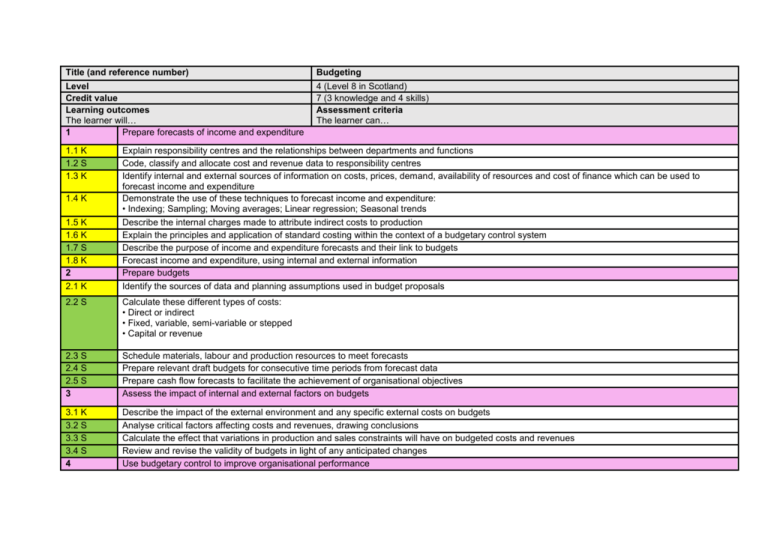
Title (and reference number) Budgeting Level Credit value Learning outcomes The learner will… 1 Prepare forecasts of income and expenditure 4 (Level 8 in Scotland) 7 (3 knowledge and 4 skills) Assessment criteria The learner can… 1.1 K 1.2 S 1.3 K 1.4 K Explain responsibility centres and the relationships between departments and functions Code, classify and allocate cost and revenue data to responsibility centres Identify internal and external sources of information on costs, prices, demand, availability of resources and cost of finance which can be used to forecast income and expenditure Demonstrate the use of these techniques to forecast income and expenditure: • Indexing; Sampling; Moving averages; Linear regression; Seasonal trends 1.5 K 1.6 K 1.7 S 1.8 K 2 2.1 K Describe the internal charges made to attribute indirect costs to production Explain the principles and application of standard costing within the context of a budgetary control system Describe the purpose of income and expenditure forecasts and their link to budgets Forecast income and expenditure, using internal and external information Prepare budgets Identify the sources of data and planning assumptions used in budget proposals 2.2 S Calculate these different types of costs: • Direct or indirect • Fixed, variable, semi-variable or stepped • Capital or revenue 2.3 S 2.4 S 2.5 S 3 Schedule materials, labour and production resources to meet forecasts Prepare relevant draft budgets for consecutive time periods from forecast data Prepare cash flow forecasts to facilitate the achievement of organisational objectives Assess the impact of internal and external factors on budgets 3.1 K 3.2 S 3.3 S 3.4 S 4 Describe the impact of the external environment and any specific external costs on budgets Analyse critical factors affecting costs and revenues, drawing conclusions Calculate the effect that variations in production and sales constraints will have on budgeted costs and revenues Review and revise the validity of budgets in light of any anticipated changes Use budgetary control to improve organisational performance 4.1 K Explain the relationship between budgetary control, product lifecycles and forecasts and planning 4.2 K Justify the uses of budgetary control for: • Planning; Co-ordinating; Authorising; Cost control Explain the behavioural aspects of budgeting Set clear targets and performance indicators to enable the budgets to be monitored Prepare a flexed budget Check and reconcile budget figures Calculate variances between budget and actual income and expenditure Report budgetary information to management in a clear and appropriate format Plan and agree draft budgets with all parties involved Analyse the variances explaining the impact that these will have on the organisation Inform management of any significant issues arising from budgetary control Present any recommendations with a clear rationale to appropriate people Identify and evaluate options and solutions to increase profitability or reduce financial losses or exposure to risk 4.3 K 4.4 S 4.5 S 4.6 S 4.7 S 5 5.1 S 5.2 S 5.3 S 5.4 S 5.5 S Unit aim(s) This unit is about forecasting and preparing budgets. The learner will develop the necessary skills and knowledge to allow them to prepare a range of budgets, analyse variances and make recommendations for improving organisational performance. They will be able to inform managers of financial forecasts to aid organisational planning and control.


